THE LIVING WORLD
Unit Six. Animal Life
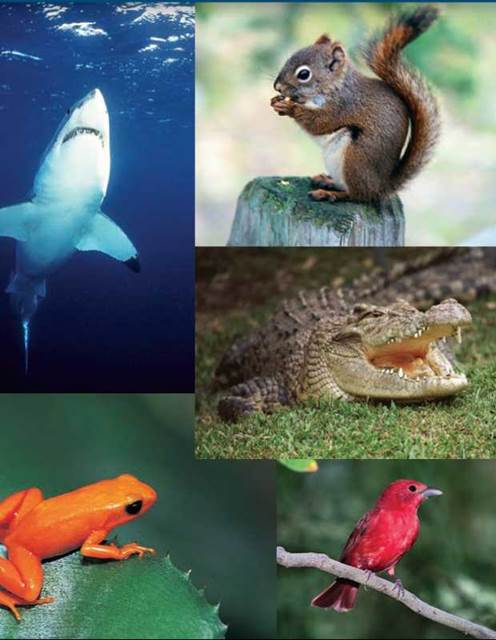
All animals obtain the energy that fuels their lives by consuming other organisms, harvesting energy-rich electrons from the organic molecules of these creatures, and then using these electrons to drive the synthesis of ATP and other molecules. Afterward, the spent electrons are donated to oxygen gas (O2) to form water (H2O), while the carbon atoms left over after the electrons were stripped from them combine with oxygen to form carbon dioxide (CO2). Capturing energy by animals is in effect a process that utilizes oxygen and produces carbon dioxide. The uptake of oxygen and the release of carbon dioxide together are called respiration, neatly defining one of the principal evolutionary challenges facing all animals—how to obtain oxygen and dispose of carbon dioxide. The evolution of respiratory mechanisms among the vertebrates has favored changes that maximize the exchange of these two gases. The most efficient respiratory mechanism to evolve in water is the gill, used by bony fishes and sharks (see photo, upper left). The earliest land vertebrates, amphibians like the frog appearing at the lower left, utilized simple lungs, and also respired through their moist skin. Reptiles like the crocodile have expandable rib cages to draw air into the lungs. The lung of mammals like the squirrel seen at the upper right have a greatly increased interior surface area, making it a more powerful respiratory machine. Birds have an improved respiratory design of the lung with air sacs and crosscurrent flow.
24.1. Types of Respiratory Systems
As discussed in chapter 7, animals obtain the energy they need by oxidizing molecules rich in energy-laden carbon-hydrogen bonds. This oxidative metabolism requires a ready supply of oxygen. The uptake of oxygen and the simultaneous release of carbon dioxide together constitute a form of gas exchange called respiration.
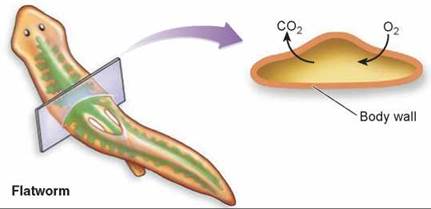
Most of the primitive phyla of organisms obtain oxygen by direct diffusion from their aquatic environments, which contains about 10 milliliters of dissolved oxygen per liter. Sponges, cnidarians, many flatworms and roundworms, and some annelid worms all obtain their oxygen by diffusion from surrounding water. Oxygen and carbon dioxide diffuse across the surface of the body, as shown in the flatworm above. Similarly, some members of the vertebrate class Amphibia conduct gas exchange by direct diffusion through their moist skin.
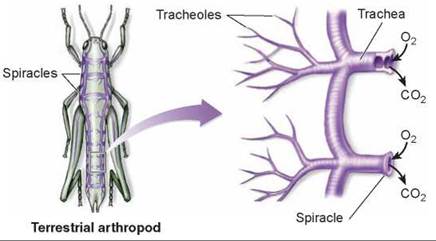
Terrestrial arthropods do not have a major respiratory organ. Instead, a network of air ducts called tracheae (the purple tubes in the figure above), branching into smaller and smaller tubes, carries air to every part of the body. The tracheae open to the outside of the body through structures called spiracles, which can be closed and opened.
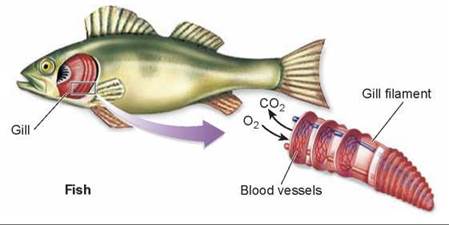
The more advanced marine invertebrates (mollusks, arthropods, and echinoderms) possess special respiratory organs called gills that increase the surface area available for diffusion of oxygen. A gill is basically a thin sheet of tissue that waves through the water. Gills can be simple, as in the papulae of echinoderms, or complex, as in the highly convoluted gills of fish. In fish, the gills are protected by a covering called an operculum (removed in the figure above). Because of this, their gills do not wave in the water, instead water is pumped over the gills and gas exchange occurs across the walls of capillaries contained in the gills.
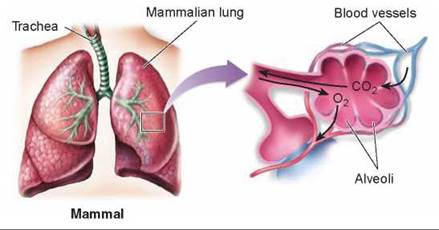
Despite the high efficiency of gills as respiratory organs in aquatic environments, gills were replaced in most terrestrial vertebrates with a pair of respiratory organs called lungs. The fine filaments of gills lack structural strength and rely on water for support: A fish out of water soon suffocates because its gills collapse. The lungs of terrestrial vertebrates are basically large air sacs, with gas exchange occurring between air drawn into the lung and blood flowing through the capillaries in the wall of the lung sac. In mammals, the surface area of the lung—and thus its oxygen-gathering capabilities—is greatly increased by tiny sub-compartments called alveoli (shown in the enlargement above).
Key Learning Outcome 24.1. Aquatic animals extract oxygen dissolved in water, some by direct diffusion, others with gills. Terrestrial animals use tracheae or lungs.